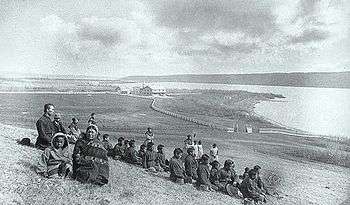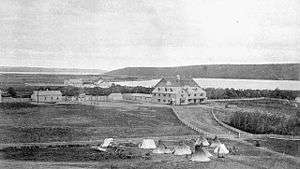Qu'Appelle Indian Residential School

Qu'Appelle Indian Residential School (Q.I.R.S.) or Qu'Appelle Industrial School was a Canadian residential school financed by the federal government. It was operated from 1884 to 1969 by the Roman Catholic Church for First Nations children and was run by the Missionary Oblates of Mary Immaculate and the Grey Nuns. It was located on what is now the Wa-Pii Moos-toosis (White Calf) Indian Reserve of the Star Blanket Cree Nation adjoining the village of Lebret, Saskatchewan.[1]
Lebret is situated on the northeast shore of Mission Lake in the Qu'Appelle Valley 6 km east of Fort Qu'Appelle on Highway 56.
History


Qu'Appelle Industrial School was built in 1884 to fulfil one of the conditions of Treaty 4, signed in 1874, which was to provide schools and education for First Nations children. Fifteen students were enrolled in the first year with Father Joseph Hugonard as the first principal. In 1886 there were 86 students and by 1914 there were 280 students.[2]
"With the assistance of the Grey Nuns, a few Oblate fathers, and lay instructors, Hugonard was to make Qu’Appelle Industrial School a model Catholic educational facility for native people and the largest such institution in Canada. The native children, in parallel boys’ and girls’ schools, attended classes for half the day and engaged in domestic or agricultural pursuits the other half. English was the language of instruction; the girls played croquet and the boys cricket."[3]
The first building was destroyed by fire in 1904 and the second Qu'Appelle Industrial School was destroyed by fire in 1932. It was replaced by the Qu'Appelle Indian Residential School in 1935. The school was expanded with additions and a gymnasium and St. Paul's High School was added to the complex in 1951.The school was closed in 1969.[4]
Sister G. Marcoux wrote a history of the school in 1955, on the occasion of the Golden Jubilee of the province of Saskatchewan[5] and an article of its history on its centenary was published.[6]
White Calf Collegiate
The school re-opened under the operations of the reserve in 1973,[7] and renamed White Calf Collegiate, but closed in August 1998.[8] White Calf Collegiate, operated by the Star Blanket Cree Nation, was demolished in 1999 a year after it closed.[1]
Students and Survivors
Photos of some students, teachers, the school and their activities may be in copies of the Indian Record and Indian Missionary Record at the Engracia De Jesus Matias Archives and Special Collections at Algoma University, through the Centre de Patrimoine, in Sister Marcoux's history,[5] and Library and Archives Canada's Residential Schools: Photographic Collections - Saskatchewan.
Some student experiences at the school are documented in the ebook: Shattering the Silence: the Hidden history of Indian residential schools in Saskatchewan.[9]
Four Saskatchewan students of the Lebret Indian school have won the Tom Longboat Award, an award that honours outstanding First Nations athletes and sportsmen in each province. National male and female winners are selected from the provincial winners.
- Arthur Obey: In 1951, the Regional (R) award at age 20 for Baseball and Hockey and in 1960 the National (N) award at age 29 for Hockey and Baseball. From the Piapot Reserve.[10]
- Herbert Strongeagle (sometimes inaccurately spelled Strong Eagle): In 1953, the Regional (R) award at age 19 for Track and field, Hockey, Baseball, and Basketball. From the Pasqua Reserve.[10]
- Gerald Starr: In 1954, the Regional (R) award at age 17 for Track and field, Hockey, Baseball, and Basketball. From the Starblanket Band.[10]
- George Poitras: In 1957, the National (N) award for Hockey, Baseball, Rugby, and Basketball. From the File Hills Reserve.[10] In 1999, he filed a lawsuit regarding his abuse and received reparation.[11]
Sports
The Lebret Indians Junior "B" Hockey Team dominated the province for five years,[12] from 1955-59. When Indian Affairs phased out grades 11-12 in 1959, Arthur Obey, the Coach of the hockey team at the school, reported it wiped out Junior "B" hockey at Lebret and the league ended up folding. Zeman et al. state Junior "B" hockey didn't return until 1962.[12] Sports were very important method of assimilation at the residential schools[13] and Lebret, for one, "developed outstanding athletic programs" and athletes. Sports and games were also by students to endure their institutionalization.[13][14]
Hockey teams at Lebret have won:
- 1952: Qu'Appelle Valley Intermediate Hockey League, First Place[12] aka Q.V.H.A Champions. See photo of winning team in the November 1952 issue of The Indian Missionary Record.[12]
- Junior "B" Atholl Murray Trophy[15] as Junior "B" Champions in 1954-55 (entered Saskatchewan Amateur Hockey Association for first time),[12] and 1955–56, 1956–57, 1957–58, 1958-59.[16][15] See photo of 1955(?) team on page 42 of Sister Marcoux,[5] and 1955-56 team in photo with Juvenile "B" team on page 241 of Zeman et al.[12]
- Juvenile "B" Shield as Juvenile "B" Champions in 1956[12][17] (but not according to the records of the Saskatchewan Hockey Association), 1957 (see team in photo on page 242 of Zemick et al[12]),[15] 1959 and, 1960.[17][16][15] See photo of 1959 Juvenile "B" Team and coaches in the April 1960 Indian Record.[18]
- Juvenile "C" Al Pickard Trophy[15] as Juvenile "C" Champions[16] 1958
- Midget "C" Ken Price Trophy[15] as Midget "C" Champions,[16] 1958.
- 1959: High School Mainline Hockey League Champions.[18]
The track and field team "dominated many local meets from 1955 to 1960."[19]
- 1959: Saskatchewan High School Athletic Association, "B" Basketball.[16]
Further:
See also
References
- 1 2 Stephen LaRose (1999). "Wrecker's ball claims White Calf Collegiate". Volume 3, issue 8, page 18. Aboriginal Multi-Media Society (Saskatchewan Sage). Archived from the original on 25 April 2015. Retrieved 14 June 2015.
- ↑ "École résidentielle Qu'Appelle (Lebret)". Société historique de Saint-Boniface. 2010. Retrieved 18 March 2017.
- ↑ Jacqueline Gresko (1998). ""HUGONARD, JOSEPH," in Dictionary of Canadian Biography, vol. 14". University of Toronto/Université Laval. Retrieved 15 June 2015.
- ↑ "Lebret healthcare: A journey through time" (PDF). Saskatchewan Population Health and Evaluation Research Unit. September 2012. Retrieved 14 June 2015.
- 1 2 3 Marcoux, Sister G. (1955). History of the Qu'Appelle Indian School, Lebret, Saskatchewan: In Fulfillment of the request by the Department of Education on the occasion of the Golden Jubilee of the Province of Saskatchewan. http://archives.algomau.ca/main/sites/default/files/2015-054_001_002_0.pdf: s.n.
- ↑ Gontran, Laviolette (October 1984). "Qu'Appelle Indian School Marks 100 Years". The Indian Missionary Record. 47[4]: 9–10.
- ↑ Westley, Annette (January–February 1973). "Indians to Manage Qu'Appelle School". The Indian Missionary record: 10.
- ↑ David McLennan (2006). "Lebret". The Encyclopedia of Saskatchewan. Retrieved 14 June 2015.
- ↑ Niessen, Shuana (n.d.). "Shattering the silence: the Hidden history of Indian residential schools in Saskatchewan". University of Regina. Faculty of Education. Retrieved November 2, 2017.
- 1 2 3 4 Forsyth, J.M. (2005). The power to define: A history of the tom longboat awards, 1951–2001. A Thesis submitted in partial fulfillment of the requirements for the degree of Doctor of Philosophy. ProQuest Dissertations & Theses Global: University of Windsor.
- ↑ Krotz, Larry (July 5, 2017). "Separate but unequal". The Walrus.
- 1 2 3 4 5 6 7 8 Zeman, B.; et al. "1955-59 Lebret Indians. In Hockey heritage: 88 Years of puck chasing in Saskatchewan". Retrieved 2017-10-27.
- 1 2 Forsyth, J. (2013). "Bodies of meaning". Aboriginal peoples and sport in Canada: historical foundations and contemporary issues. Vancouver, B.C.: UBC Press. pp. 15–34. ISBN 9780774824224.
- ↑ Truth and Reconciliation Commission (2015). "Sports and the arts: 1940 to 2000". Canada's residential schools: the History, part 2, 1939 to 2000. Volume 1. The Final report of the Truth and Reconciliation Commission of Canada. Montreal & Kingston: McGill-Queen's University Press. p. 471. ISBN 9780773546516.
- 1 2 3 4 5 6 "Along Saskatchewan's Hockey Trail: Saskatchewan champions" (PDF). Saskatchewan Hockey Association. November 1, 2017.
- 1 2 3 4 5 6 "Sports Leaders Honoured: Arthur Obey And Tony Cote". Saskatchewan Indian. 10[2-3]: 5. February–March 1980.
- 1 2 3 Balcarres Free Lance (March 1961). "Art Obey Top Indian Athlete" (PDF). Indian Record. XXIV (III): 7.
- 1 2 "Two day vocation seminar at St. Paul's High School" (PDF). Indian Record. XXIII[4]: 3. April 1960.
- ↑ Truth and Reconciliation Commission (2015). Canada's residential schools: the History, part 2, 1939 to 2000. Volume 1. The Final report of the Truth and Reconciliation Commission of Canada. Montreal & Kingston: McGill-Queen's University Press. p. 471. ISBN 9780773546516.
External links
Coordinates: 50°45′32.9″N 103°42′40.26″W / 50.759139°N 103.7111833°W